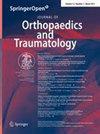电容性生物物理刺激改善脊椎脆性骨折的愈合:一项前瞻性多中心随机对照试验
IF 3
2区 医学
Q1 ORTHOPEDICS
引用次数: 0
摘要
电容耦合电场(CCEF)是一种非侵入性生物物理刺激方法,可促进骨折修复和脊柱融合。这项多中心随机对照试验旨在进一步研究电容耦合电场在以下方面的作用:(1)通过磁共振成像随访研究了解椎体骨髓水肿(VBME)的消退情况;(2)与未接受刺激的患者相比,接受刺激的急性椎体脆性骨折(VFF)转诊患者的疼痛缓解情况、镇痛药物消耗量和生活质量改善情况。2016年9月至2019年12月期间,参与这项多中心随机临床研究的脊柱中心将转诊的OF1型或OF2型急性椎体脆性骨折患者纳入本研究。所有 VFF 均按照 "良好临床实践 "进行保守治疗。此外,患者被随机分为两组:CCEF组作为临床研究方案的辅助手段,接受CCEF设备(Osteospine,IGEA)的生物物理刺激,每天8小时,持续60天;而对照组则按照临床研究方案进行治疗。在基线(T0)、30 天随访(T1)、60 天随访(T2)和 6 个月随访(T3)期间,每位患者都接受了疼痛视觉模拟量表(VAS)和 Oswestry 残疾指数(ODI)的临床评估。根据疼痛强度,患者需接受为期 7 天(或更长时间)的扑热息痛 1000 毫克片剂镇痛治疗;患者需在研究第 8 天至随访 180 天期间在特定表格上报告其扑热息痛用量。所有参与研究的中心都使用了 1.5 T 核磁共振成像系统,在随访的 0 天(T0)、30 天(T1)和 60 天(T2)对胸腰椎进行了核磁共振成像检查。通过核磁共振成像检查的每个 VBME 区域,都对椎体几何形状(即前壁高度/后壁高度和椎体后凸)进行了评估。本研究共纳入了 66 名患有 69 个 VFF 的患者(男性:9 名,占 13.63%;平均年龄:73.15 岁),并对其进行了以下随机分组:33 名患者被纳入对照组,其余 33 名患者被随机纳入 CCEF 组。在CCEF组中,患者对CCEF疗法的依从性良好(依从性=94%),且无不良反应记录。与对照组患者相比,受刺激组患者的椎体后凸轮增生(VBME)消退更快,随访期间椎体塌陷明显减少。此外,在积极治疗组中,疼痛减轻的速度更快,ODI 平均得分也有所提高。从治疗后的第三次随访到 6 个月的随访期间,受刺激患者的扑热息痛用量也明显减少。就性别差异而言,在CCEF组,男性患者的VBME缓解速度快于女性。作为传统保守治疗的辅助手段,CCEF生物物理刺激是加速VBME缓解过程和防止椎体变形的有效工具。这些磁共振成像结果也与背痛的快速缓解和生活质量的改善相关。从治疗后的第三次随访到 6 个月的随访,刺激组患者的扑热息痛用量明显低于对照组患者,尽管两组患者的背痛和生活质量没有明显差异。II.试验注册登记:ClinicalTrials.gov,编号:NCT05803681:NCT05803681。本文章由计算机程序翻译,如有差异,请以英文原文为准。
Capacitive biophysical stimulation improves the healing of vertebral fragility fractures: a prospective multicentre randomized controlled trial
Capacitively coupling electric fields (CCEF) is a method of non-invasive biophysical stimulation that enhances fracture repair and spinal fusion. This multicentre randomized controlled trial aimed to further examine the roles of CCEF in (1) the resolution of vertebral bone marrow oedema (VBME) using a follow-up MRI study and (2) pain relief, analgesic drug consumption and quality of life improvement in stimulated patients who were referred with acute vertebral fragility fractures (VFFs) compared to non-stimulated patients. Between September 2016 and December 2019, patients who were referred to the spine centres that participated in this multicentre randomized clinical study with acute VFFs of type OF1 or OF2 were included in the present study. All the VFFs were conservatively managed according to Good Clinical Practice. Moreover, the patients were randomized into two groups: the CCEF group received, as an adjunct to the clinical study protocol, biophysical stimulation with a CCEF device (Osteospine, IGEA) for 8 h per day for 60 days, whereas the control group was treated according to the clinical study protocol. At baseline (T0), the 30-day follow-up (T1), the 60-day follow-up (T2), and the 6-month follow-up (T3), each patient underwent clinical evaluation using the Visual Analogue Scale (VAS) for Pain and the Oswestry Disability Index (ODI). Analgesic therapy with paracetamol 1000 mg tablets for 7 days—or longer, depending on the pain intensity—was performed; patients were required to report their paracetamol consumption on a specific sheet between study day 8 to 180 days of follow-up. MRI studies of the thoracolumbar spine were performed at 0 (T0), 30 (T1) and 60 days of follow-up (T2) using a 1.5-T MRI system in all of the centres that took part in the study. For each VBME area examined via MRI, the vertebral body geometry (i.e. anterior wall height/posterior wall height and vertebral kyphosis) were assessed. A total of 66 patients (male: 9, 13.63%; mean age: 73.15 years old) with 69 VFFs were included in the present study and randomized as follows: 33 patients were included in the control group and the remaining 33 patients were randomized into the CCEF group. In the CCEF group, good compliance with CCEF therapy was observed (adherence = 94%), and no adverse effects were recorded. In the stimulated patients, faster VBME resolution and significantly less vertebral body collapse during follow-up were observed compared to the control patients. Moreover, in the active group, faster pain reduction and improvement in the ODI mean score were observed. Stimulated patients also reported a significantly lower paracetamol consumption rate from the third follow-up after treatment until the 6-month follow-up. In terms of sex-related differences, in the CCEF group, VBME showed a faster resolution in male patients compared with females. Biophysical stimulation with CCEF, as an adjunct to traditional conservative treatment, is a useful tool to hasten the VBME resolution process and prevent vertebral body deformation. These MRI findings also correlate with faster back pain resolution and quality of life improvement. From the third follow-up after treatment until
the 6-month follow-up, stimulated patients reported a significantly lower paracetamol consumption than control patients, even though back pain and quality of life showed no significant differences between the two groups. II. Trial Registration Register: ClinicalTrials.gov, number: NCT05803681.
求助全文
通过发布文献求助,成功后即可免费获取论文全文。
去求助
来源期刊

Journal of Orthopaedics and Traumatology
Medicine-Orthopedics and Sports Medicine
CiteScore
4.30
自引率
0.00%
发文量
56
审稿时长
13 weeks
期刊介绍:
The Journal of Orthopaedics and Traumatology, the official open access peer-reviewed journal of the Italian Society of Orthopaedics and Traumatology, publishes original papers reporting basic or clinical research in the field of orthopaedic and traumatologic surgery, as well as systematic reviews, brief communications, case reports and letters to the Editor. Narrative instructional reviews and commentaries to original articles may be commissioned by Editors from eminent colleagues. The Journal of Orthopaedics and Traumatology aims to be an international forum for the communication and exchange of ideas concerning the various aspects of orthopaedics and musculoskeletal trauma.
 求助内容:
求助内容: 应助结果提醒方式:
应助结果提醒方式:


